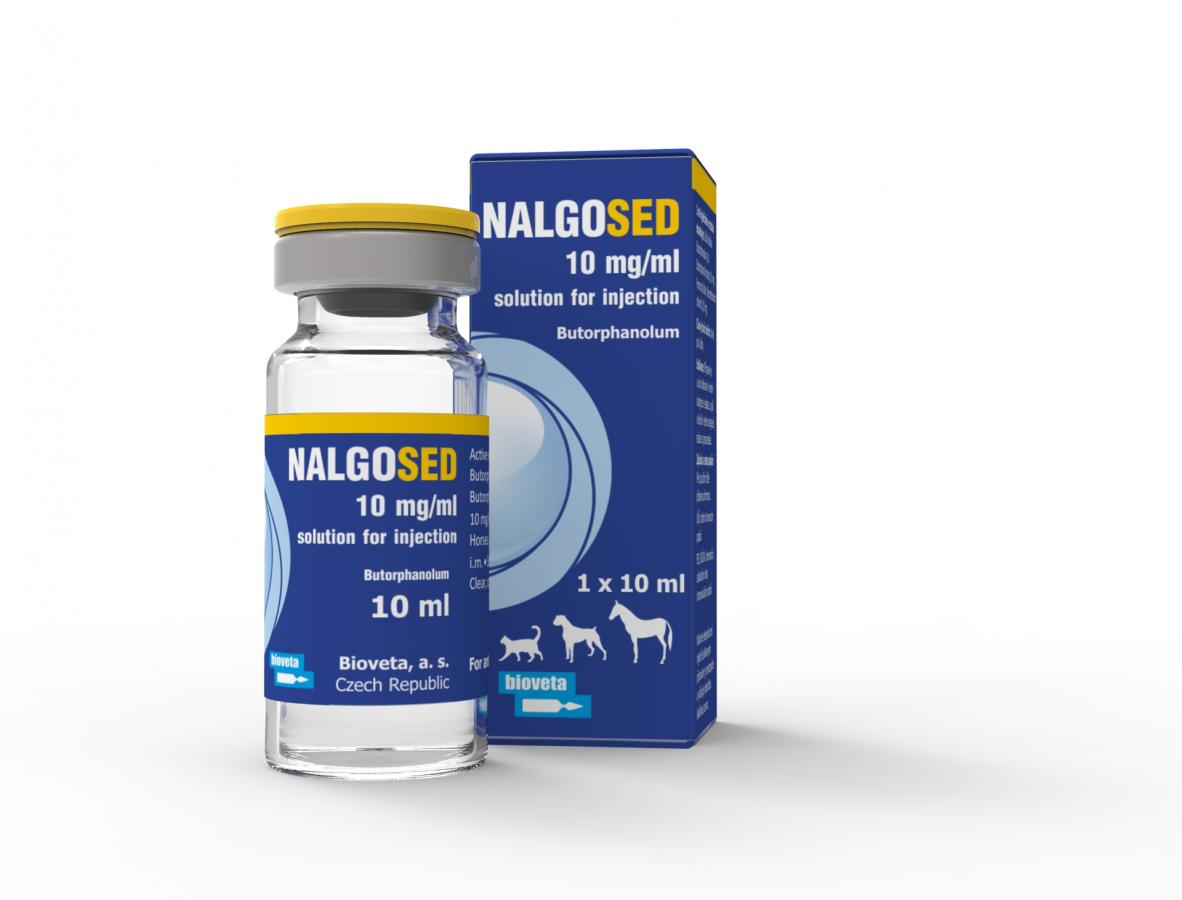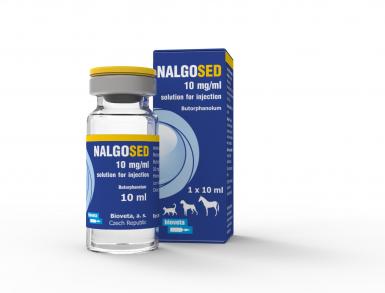NALGOSED 10 mg/ml injection solution
Homepage Products Veterinary products NALGOSED 10 mg/ml injection solution
Centrally acting analgesic from the group of synthetic opiates.
| type of preparative: | Analeptic, anaesthetic, hypnotics |
|---|---|
| target species animals: | Dog, Cat, Horse |
Composition
1 ml of the product contains butorphanol 10 mg
(as Butorphanol tartrate 14.58 mg)
Target species
Dogs, cats and horses.
Indication
The product contains butorphanol, an analgesic with an opioid, central action. Butorphanol is suitable for preoperative analgesia before inducing anaesthesia using various products.
Preanaesthetic administration of the product reduces the dose of general anaesthetics, especially sodium thiopental. The product is administered as a part of the anaesthesia protocol in combination with medetomidine hydrochloride and ketamine.
Dogs
Analgesic: Alleviation of mild to severe pain associated with postoperative procedures, especially after orthopaedic surgery or soft tissue surgery.
Sedative: In combination with medetomidine hydrochloride.
Preanaesthetic: Preanaesthetic administration of the product reduces the dose of general anaesthetic, especially sodium thiopental. The product is administered as a part of the anaesthesia protocol in combination with medetomidine hydrochloride and ketamine.
Horses
Analgesic: To alleviate mild to severe abdominal pain of gastrointestinal origin including a colic. The product alleviates pain related to a colic or labour and delivery conditions.
Sedative: For sedation after administration of determined alpha2-adrenoceptor agonists (detomidine hydrochloride, romifidine).
Sedation in therapeutic and diagnostic procedures in standing animals.
Cats:
Analgesic: Alleviation of mild to severe pain associate with surgery procedures, especially with castration, orthopaedic surgery or soft tissue surgery.
Sedative: In combination with medetomidine hydrochloride.
Preanaesthetic administration of the product reduces the dose of general anaesthetic, especially sodium thiopental. The product is administered as a part of the anaesthesia protocol in combination with medetomidine hydrochloride and ketamine.
Route of administration and dosage
Horse: Only for intravenous administration (IV).
Dog, cat: Intravenous (IV), subcutaneous (SC.) or intramuscular (IM) administration.
Avoid bolus application where IV administration is used. Avoid an excessively rapid IV administration. Different application sites should be used for repeated SC or IM administration.
Horses
When used as an analgesic:
Butorphanol alone:
To be applied in the dose of 0.1 mg/kg of live weight, which is equivalent to 0.01 ml of the product/kg of live weight, i.e. 1 ml/100 kg of live weight i.v.
The dosing can be repeated as needed. The analgesic effect develops in 15 minutes from application.
As a sedative:
Butorphanol in combination with detomidine:
Detomidine hydrochloride should be applied in the dose of 0.012 mg/kg of live weight i.v. Subsequently, 5 minutes later butorphanol should be applied in the dose of 0.025 mg/kg of live weight, which is equivalent to 0.0025 ml of the product/kg of live weight, i.e. 0.25 ml of the product/100 kg of live weight i.v.
Butorphanol in combination with romifidine:
Romifidine should be applied in the dose of 0.04–0.12 mg/kg of live weight i.v. Subsequently, 5 minutes later butorphanol should be applied in the dose of 0.02 mg/kg of live weight, which is equivalent to 0.002 ml of the product/kg of live weight, i.e. 0.2 ml of the product/100 kg of live weight i.v.
Dogs
As an analgesic
Butorphanol alone:
To be applied in the dose of 0.2–0.3 mg/kg of live weight, which is equivalent to 0.02–0.03 ml of the product/kg of live weight, i.e. 0.2–0.3 ml of the product/10 kg of live weight i.v., i.m. or s.c.
The product should be applied 15 minutes before the end of anaesthesia to provide an analgesic effect in the recovery phase. Analgesic effect can be observed in 15 minutes. For continuous analgesia, dosing can be repeated as needed.
As a sedative
Butorphanol in combination with medetomidine:
Butorphanol should be applied in the dose of 0.1 mg/kg of live weight, which is equivalent to 0.01 ml of the product/kg of live weight IV or IM. Medetomidine hydrochloride should be applied immediately thereafter in the dose of 0.01–0.025 mg/kg of live weight IV or IM. Both agents should be administered separately, not in a single syringe.
Before initiating the therapeutic procedure, wait for 20 minutes after the application for sufficient sedation.
Atipamezole should be applied in the dose of 0.05–0.125 mg/kg of live weight to return from anaesthesia. The patient assumes the sternal position approximately in 5 minutes and stands up after additional 2 minutes.
As a preanaesthetic
Butorphanol alone:
To be applied in the dose of 0.1–0.2 mg/kg of live weight, which is equivalent to 0.01–0.02 ml of the product/kg of live weight IV, IM or SC.
To be applied 15 minutes before inducing anaesthesia.
As a sedative and preanaesthetic – premedication of barbiturate anaesthesia:
Butorphanol in combination with medetomidine:
Butorphanol should be applied in the dose of 0.1 mg/kg of live weight, which is equivalent to 0.01 ml of the product/kg of live weight IV. or IM. Medetomidine hydrochloride should be applied immediately thereafter in the dose of 0.01 mg/kg of live weight i.v. or i.m. Both agents should be administered separately, not in a single syringe (see section 6.2 Incompatibilities).
As a part of the anaesthesia protocol:
Butorphanol in combination with medetomidine and ketamine:
Butorphanol should be applied in the dose of 0.1 mg/kg of live weight, which is equivalent to 0.01 ml of the product/kg of live weight i.m. Medetomidine hydrochloride should be applied immediately thereafter in the dose of 0.025 mg/kg of live weight IM. Both agents should be administered separately, not in a single syringe (see section 6.2 Incompatibilities). After 15 minutes, ketamine should be applied in the dose of 5 mg/kg of live weight IM.
Sedation and the onset of anaesthesia develop approximately in 6 minutes from the first application. Extinction of the pedal reflex occurs approximately in 14 minutes. Anaesthesia subsides approximately in 53 minutes from ketamine application – the pedal reflex returns. The patient assumes the sternal position approximately in 35 minutes and stands up after additional 36 minutes.
Atipamezole is not recommended to reverse anaesthesia when butorphanol is used in combination with medetomidine / ketamine.
Cats
As a preoperative analgesic
Butorphanol alone:
To be applied in the dose of 0.4 mg/kg of live weight, which is equivalent to 0.04 ml of the product/kg of live weight, i.e. 0.2 ml/5 kg of live weight IM or SC.
When intravenous induction of anaesthesia is used, butorphanol should be applied 15–30 minutes before administering the anaesthetic.
When intramuscular induction of anaesthesia is used (acepromazine/ketamine or xylazine/ketamine), butorphanol should be applied 5 minutes before administering the anaesthetic. The use of butorphanol has no distinct effect on the awakening period.
As a postoperative analgesic:
Intramuscular; subcutaneous administration: Butorphanol should be applied separately in the dose of 0.4 mg/kg of live weight, which is equivalent to 0.04 ml of the product/kg of live weight, i.e. 0.2 ml/5 kg of live weight SC. or IM.
Intravenous administration: Butorphanol should be applied separately in the dose of 0.1 mg/kg of live weight, which is equivalent to 0.01 ml of the product/kg of live weight, i.e. 0.05 ml/5 kg of live weight IV.
To be applied 15 minutes before awakening from anaesthesia.
As a sedative:
Butorphanol in combination with medetomidine:
Butorphanol should be applied in the dose of 0.4 mg/kg of live weight, which is equivalent to 0.04 ml of the product/kg of live weight IM or SC. Medetomidine hydrochloride should be applied immediately thereafter in the dose of 0.05 mg/kg of live weight SC or IM. Both agents should be administered separately, not in a single syringe
Local anaesthesia should be used for surgical suturing of wounds.
Atipamezole should be applied in the dose of 0.125 mg/kg of live weight to return from anaesthesia. The patient assumes the sternal position approximately in 4 minutes and stands up after an additional 1 minute.
As a part of the anaesthesia protocol:
Butorphanol in combination with medetomidine and ketamine:
Intravenous administration (IV):
Butorphanol should be applied in the dose of 0.1 mg/kg of live weight, which is equivalent to 0.01 ml of the product/kg of live weight IV. Medetomidine hydrochloride should be applied immediately thereafter 0.04 mg/kg of live weight IV and ketamine in the dose of 1.25–2.5 mg/kg of live weight IV; ketamine should be dosed based on the required depth of anaesthesia. The agents should be administered separately, not in a single syringe (see section 6.2 Incompatibilities).
The patient lies down in 2–3 minutes from the application. Extinction of the pedal reflex occurs approximately in 3 minutes from the application. Atipamezole should be applied in the dose of 0.2 mg/kg of live weight to return from anaesthesia. The pedal reflex returns approximately in 2 minutes; the patient assumes the sternal position approximately in 6 minutes and stands up after additional 18 minutes.
Intramuscular administration (IM)
Butorphanol should be applied in the dose of 0.4 mg/kg of live weight, which is equivalent to 0.04 ml of the product/kg of live weight i.m. Medetomidine hydrochloride should be applied immediately thereafter in the dose of 0.08 mg/kg of live weight i.m. and ketamine in the dose of 5 mg/kg of live weight i.m. The agents should be administered separately, not in a single syringe (see section 6.2 Incompatibilities).
The onset of the effect and its subsiding depend on the administered dose of ketamine. The patient lies down in 1 minute including the pedal reflex loss. The anaesthesia lasts up to 60 minutes without any additional medication (sternal position resumed) and the patient stands up in 70–83 minutes. Atipamezole should be applied in the dose of 0.1 mg/kg of live weight to return from anaesthesia. The pedal reflex returns approximately in 4 minutes; the patient assumes the sternal position approximately in 7 minutes and stands up after additional 18 minutes.
Overdose
Respiratory depression is the most important consequence of overdose. Opioid receptor antagonists (e.g. naloxone) are suitable antidotes.
Atipamazole is a suitable antidote in case of overdose of butorphanol in combination with medetomidine hydrochloride or ketamine, with the exception of intramuscular administration of the butorphanol/medetomidine/ketamine combination in dogs.
Storage
Do not freeze.
Protect from light.
Cold chain storage is not required but it is advisable not to exceed 25 °C.
Withdrawal period
Horses (milk and meat) - zero.
Shelf life
Shelf-life of the veterinary medicinal product as packaged for sale: 3 years.
Shelf-life after first opening the immediate packaging: 28 days.
Package
1x10 ml.










